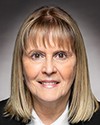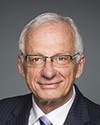Thank you very much, Chair.
Good morning, everyone. I want to acknowledge the committee and, if I may say, Chair Bratina, I also honour your expressions of remorse and what you shared with us about your wife in a very personal conversation. I think that speaks to our shared humanity as we come round this issue.
I want to acknowledge Deputy Minister Quan-Watson as well for [Technical difficulty—Editor] coming to you from Treaty 8 territory [Technical difficulty—Editor] peoples of the Dene Nation. I know Daniel lived here, but he also worked with us and paid attention to us throughout the work of our commission.
I also want to acknowledge my fellow commissioners. Good morning to you both. It's good to see you both. Thank you very much, Chief Littlechild, for your very personal sharings as well.
I acknowledge our NCTR relatives. I refer to them in that way because, in speaking of them, the existence of the National Centre for Truth and Reconciliation was something that our commission gave birth to. It was part of our mandate with the Truth and Reconciliation Commission, and they carry on the very important and reverent work of safekeeping all that we learned and all that was given to us by way of teachings and material effects during the commission's work.
I also want to acknowledge any survivors or intergenerational survivors who may be in the room, on this committee or joining us in other ways and whose voices and, I have to say, relentless advocacy and efforts have brought us to this time and place.
Finally, and most particularly, I want to acknowledge and honour all those across the country who are grieving and who are, at the same time, feeling expressions of feeling validated for all that they have told us and all that is beginning to be heard.
I was thinking, if only I could say happy anniversary, but we're not here to celebrate. Rather, we're here to hold up to the light those things that, in fact, we have known about for years but have until now denied, ignored, or given insufficient attention, resources, or the urgency needed for action to follow.
What was happening six years ago today—six years ago, exactly, yesterday? In fact, thousands of residential school survivors and others from throughout the land were gathered in Ottawa to witness, receive and celebrate the conclusions of the Truth and Reconciliation Commission of Canada. We three commissioners stood together to release the summary report of our findings, a full volume of survivors' voices—some of whom talked precisely about this issue—10 founding principles of reconciliation and 94 calls to action. We have today referenced only the calls to action numbering in the 70s, which are particularly about this, but there are others calls to action that are interrelated, such as number 82, which calls for a national monument, in part to have a commemorative place for the unknown child—those who we haven't yet found and may never find.
My part in those final speeches that day was, in fact, about the missing children. We talked about it a lot at that time, and that was six years ago.
A few months later, we released our multi-volume, full report, and our chair, Mr. Sinclair, has just referred you to volume 4, an entire volume devoted to missing children and unmarked burials.
Commissioner Littlechild has talked to you about the chairs we had in place, the empty chairs, usually two of them, one for all the little boys and one for all the little girls, so they would be ever present in front of mind in our thinking and in our work.
The conclusions in our reports did not come from thin air. They came from historic documents, from new research that was commissioned by us and from 7,000 recorded voices of former residential school student survivors, each one of them an expert on their own lived experiences, what happened to them, what happened to friends and family members, what they witnessed and those they never saw again.
Well, that was six years ago. What was happening nine years ago? In public hearings open to all who cared to pay attention, because all of our activities were public and most of them web-streamed, survivor women in Chisasibi, northern Quebec, entrusted me with this baby rattle, the shiishiikun. They conveyed a particular responsibility to me as the woman commissioner, sometimes referred to as the mother commissioner, to do all that we could to find and free the spirits of the missing children.
What was happening 11 years ago? At one of our very earliest TRC events, in Winnipeg, we sat in a circle, which included the then Conservative Minister of Aboriginal Affairs and a former chief, who implored us to find their missing relative, one who had never returned home from residential school.
What was happening 13 years ago? Leaders from each and every one of your political parties stood in the House of Commons to offer official apologies for your parties' and for respective governments' roles in imposing and perpetuating the residential school system. Very importantly, each one promised to work together to make things right in the spirit of reconciliation.
We are called together again today in what you have deemed an emergency session. I've been pondering this question: When does the known, when does the atrocious become an emergency? I'm very, very grateful for this expression of urgency but I am dismayed that it's being framed using the poor language that we have to work with, that it's being called “discovery of human remains”. This is not a discovery, which is why I have reminded you of this history. It is the validation of all that we have previously and repeatedly been told and have been saying. These are not statistics. We know the number, but these are not statistics. By the way, these are also not all of the children we know to have died at school. We already knew of 52 in our existing records. These are not statistics; these are little children, some of them possibly now forever unknown but all of them loved and none of them ever forgotten.
What can Canada do?
I've tried to wrap my head around what we might offer back as you go forward with your deliberations. Commissioner Sinclair touched on it already, and I think it's extremely important. First is a continued and sustained non-partisan response and prioritization of resources needed to do this work and all that is being addressed under that broad banner of reconciliation. We have repeatedly said that reconciliation is a non-partisan issue.
Next is accountability, so that we hold ourselves as a country to the international standards and expectations that we would in fact, and we have in the past, advocated for with respect to other countries, including in terms of the consideration of crime and crimes against humanity.
I would ask for honest language and that we not make ourselves comfortable with phrases such as “a sad chapter in our history”. Is it that or is it a human rights atrocity? Is it a social policy mistake or, in this story, was it a breeding ground for crime and abuse? With my appreciation for your committee, your focus and your commitment, for which I'm very grateful, I want you to push for this to be seen more and more as not just an issue for indigenous and northern affairs. It is an issue of human rights and of justice that is of critical importance to all Canadians and to our very principles of democracy.
It is for all of government, and I would say all of governments, as we say repeatedly in our calls to action, and the federal government with its particular ability and influence and powers to convene across all governments. Call to action number 75 in particular is very specific about that. Many of these residential schools and the burial sites are no longer on church-owned properties or even public properties. Many of them are now in private hands, and there's going to be a need for collaboration among private landowners, municipalities, indigenous leaders, provincial governments and territorial ones as well.
Then I would ask for transparency and comprehensive reporting, and, of course, that flows most easily when you have a comprehensive strategy that has been communicated and that we all know about. That way, we can know what progress is being made without having to depend on the government purporting to have done things without anyone else being well aware of them.
I am aware, in fact, of the initiatives that are under way within the indigenous affairs department on this file. Has it advanced enough? Has it advanced fast enough? Are people aware of its existence?
I think these are things we need to communicate thoroughly, frequently and in a comprehensive way, so we understand how these efforts tie in with the other efforts that are all intertwined in our calls to action. I really encourage you and all others not to limit yourselves to the calls to action that number in the 70s.
Act on the obvious. As an example, take number 82, which is outside that bundle in the 70s. It calls for a national monument to honour all students who went to residential schools, knowing that it also is intended to serve as the tomb of the unknown child, if you will, and accepting, as we must, that not all the children we will find will ever be identified. Will we ever know exactly where they came from and who they belonged to?
I would like to end by saying that I would like us to embrace—without making crass comparisons—the valuable lessons of COVID, where we have shown and proven to ourselves that we know how to give urgent response. We know how to do whatever it takes, whatever it costs, when it has to do with the right thing, when it has to do with us taking care of each other, and when it has to do with making sure we are living up to the standards we say we believe in as a country.
I want to end, if I may, where I began, by honouring all the generations of little ones who were taken from their homes and displaced from everything and everyone they knew, and by acknowledging the little children lying in Kamloops. This past week they have risen up and they have begun to be heard across the country. They have brought Canada to the forefront of international attention. It's our responsibility collectively, I think, to continue to listen to them and to make every effort to find the others throughout the land who are still missing.
I look forward to your questions and conversation. Thank you very much.
Marsi cho.



